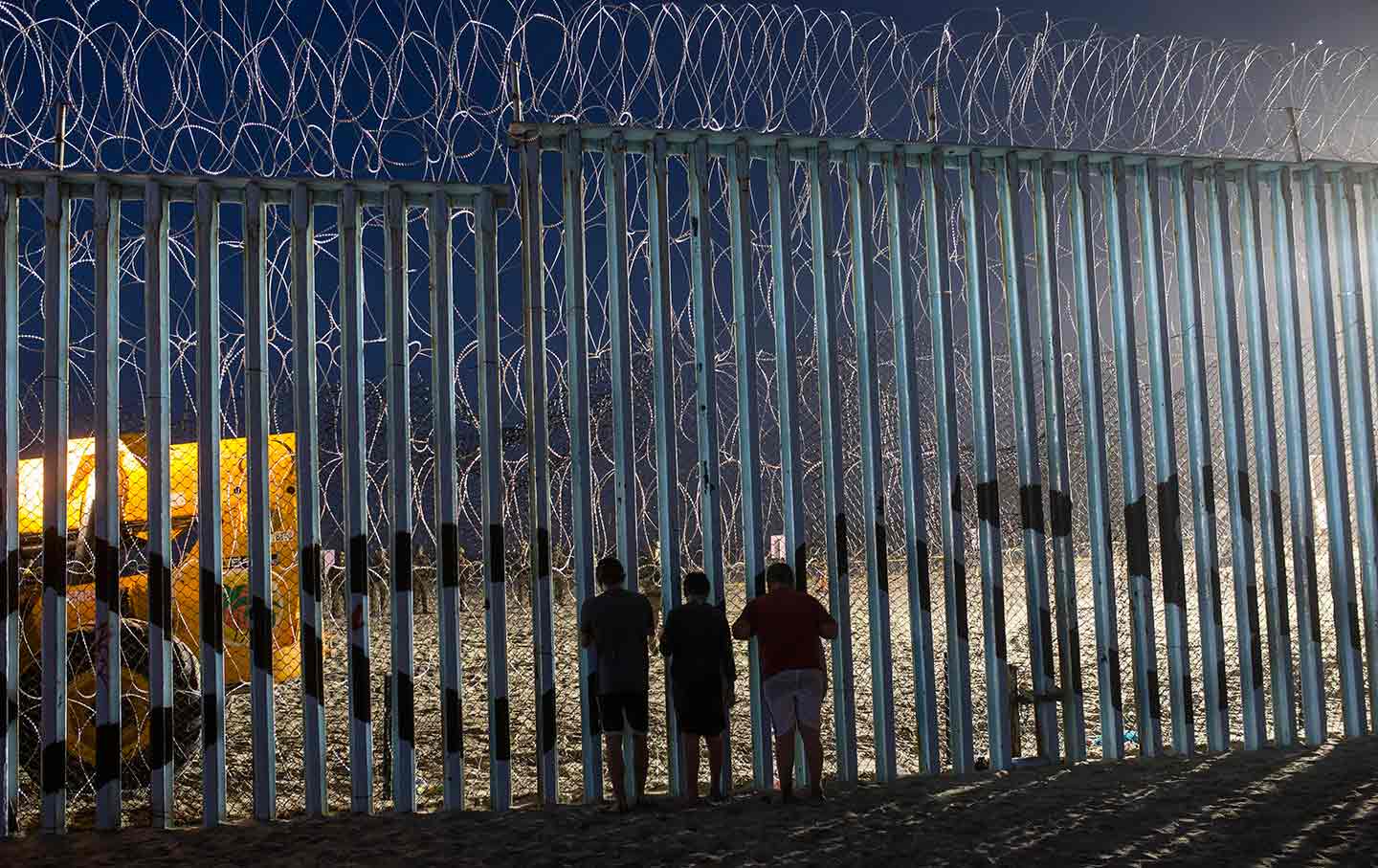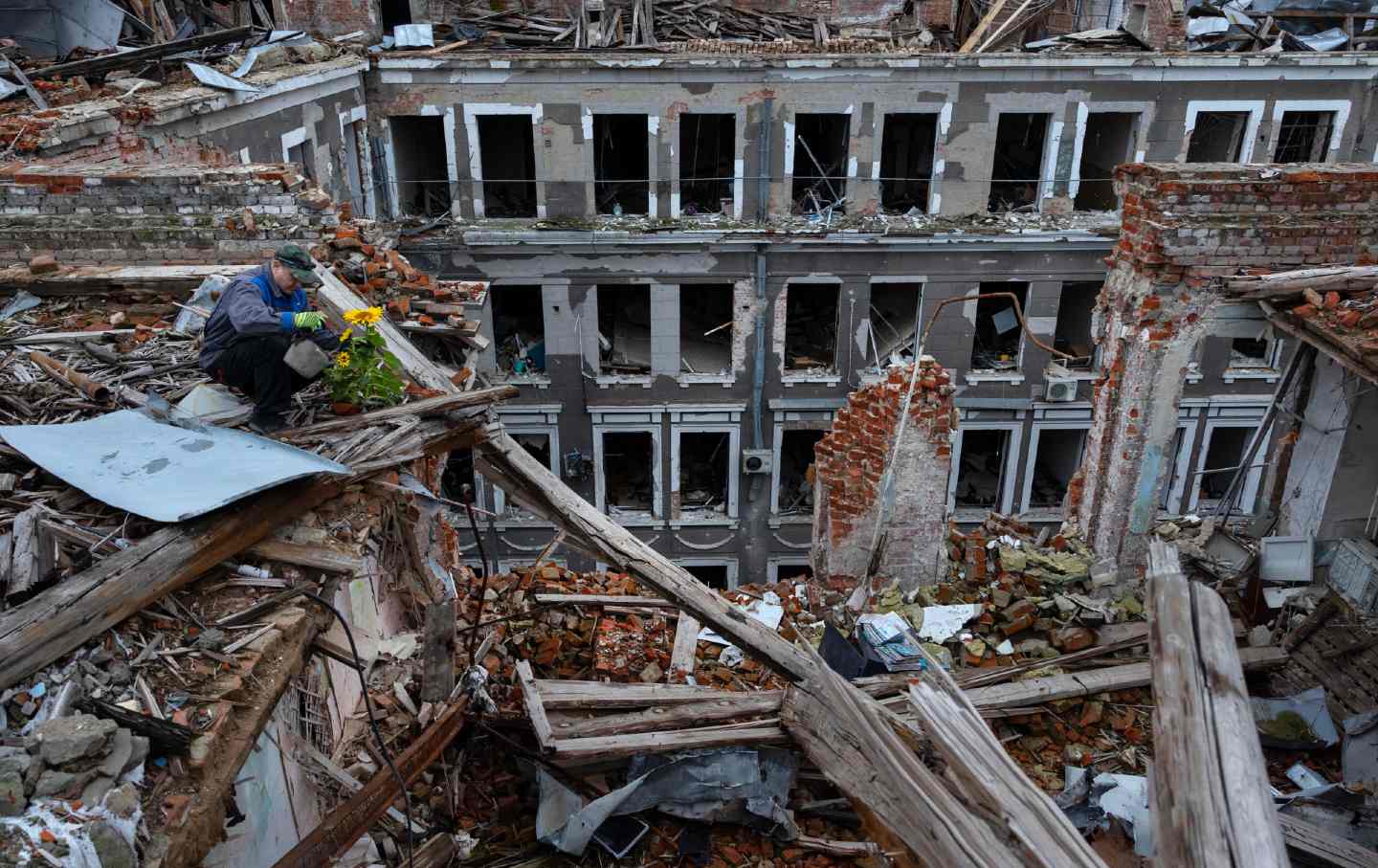Biden’s Supposed “Open-Border Policy” Does Not Exist
Just a glance at 2023 border contracts suggests that more walls, detention centers, and expulsion flights are coming.

Children observe the movements of the US Border Patrol agents from the Mexican side where the border meets the Pacific Ocean, Tijuana, Mexico, on Friday, November 16, 2018.
(Rodrigo Abd / AP Photo)This article originally appeared at TomDispatch.com. To stay on top of important articles like these, sign up to receive the latest updates from TomDispatch.com.
On September 23, at about 2:30 am, a Border Patrol surveillance camera captured two people crossing the international boundary between Mexico and the United States on the outskirts of Nogales, Arizona. A Border Patrol vehicle arrived quickly, but not before one of them had fled back into Mexico. When an armed agent stepped out, dressed in a forest-green uniform, he found a 16-year-old girl from Mexico softly crying, while holding her month-old baby swaddled in a blanket.
The agent commanded her to get in the vehicle. As they then drove to the Nogales Border Patrol station, the girl, he later reported, tried to speak to him in Spanish through the security partition that separated them. Her tiny daughter, she was telling him, was in distress. Cameras showed that the vehicle stopped for all of 10 seconds before continuing. The agent later claimed he couldn’t understand what she was saying and that he wanted to find a fluent Spanish speaker at the station. He didn’t realize, he insisted, that the infant was struggling to breathe, though the child soon died.
This hellish story of suffering at our border is but one of hundreds of similar tales of horror from 2023. They illustrate a fundamental truth about that border: It neither is, nor ever was, an “open” one in the Biden years, nor does the president faintly have an open-border policy, though prepare yourself to hear otherwise—over and over again—in Trumpublican campaign ads next year. They’ll repeat what party officials are already saying all too repetitively: that “President Biden’s radical open borders policies” have created “the worst border crisis in American history.” (While those are the exact words of House Oversight Committee chair James Comer, similar sentiments are already being offered by countless members of the GOP.)
Comer’s claim is, of course, no less predictable than the hardships migrants like that girl are suffering as they try to reach this country. While such border narratives traffic in the unreal, what is real either isn’t effectively reported or gets lost amid all the politically motivated noise. Loud fantasies are expansively covered, while life-and-death stories, like those of that infant and her mother, are seldom reported and, if they are, quickly disappear.
Barely a week before that 16 year old was desperately trying to communicate to the agent in Spanish, the United Nations International Organization for Migration (IOM) labeled the US-Mexico border the world’s “deadliest migration land route.” In 2022, a record 853 remains of dead border crossers were recovered (and this is the US Border Patrol’s figure, which is even higher than the IOM’s), dwarfing the record of 568 set the previous year. Such numbers, the IOM stresses, are known to be distinct undercounts, leaving all too many families pining for lost loved ones.
But those border fatalities weren’t the only record breaker. Another was confirmed just a week after medical personnel at the Nogales station rushed to treat that girl’s baby. The number of border contracts issued to private industry also set a new record. Like those deaths, such contracts soared in fiscal year 2023 to $9.96 billion, instantly stripping the previous high, also set last year, of $7.5 billion.
And mind you, those gifts to industry were made from the highest budget ever (including in the Trump years) for border and immigration enforcement: $29.8 billion. So, don’t for a second think that the United States has an “open” border. In fact, it’s never been more fortified or—something few even bother to mention—more profitable, if you happen to be part of the border-industrial complex.
Biden and the Border-Industrial Complex
If you count all the contracts for private industry from US Customs and Border Protection (CBP) and US Immigration and Customs Enforcement (ICE) since Joe Biden took office—for, that is, 2021, 2022, and 2023—the number comes to $23.5 billion. And though you’d never guess it, given what we normally hear, that already beats Donald Trump’s total for his full four years in office, $20.9 billion. Or, to put the matter in a more historical perspective, private contracts for the Biden years already top the cumulative $22.5 billion spent in border and immigration enforcement budgets from 1975 to 1997. That’s 22 years if you weren’t counting.
In other words, it’s essentially guaranteed that the Biden administration will break all records for paying border contractors. And, in truth, if it weren’t for the “open borders” political mania of the moment, this wouldn’t be a surprise at all. Remember, while running for president in 2020, Biden received three times more campaign contributions than Trump from members of the top companies in the border industry. (The Donald talked a good game, of course, and received his share of the industry pie over the years, but that same border-industrial complex was right if it thought Biden would all too literally pay off for them.)
And keep in mind as well that Department of Homeland Security Secretary Alejandro Mayorkas represented some of the top border companies like Leidos and Northrop Grumman at a private law firm (where he earned $3.31 million) before joining the Biden administration. While the president has certainly traded in the hostile rhetoric associated with the bombastic Trump for a far more sterile and bureaucratic language, while adding in a healthy dose of the “humane,” budgets and private-sector contracts tell an all-too-familiar story in which the border-enforcement apparatus only continues to grow ever larger, regardless of who’s president.
As 2023 nears its end, there have simply never been as many opportunities to make a killing (figuratively as well as literally) by surveilling, arresting, caging, and expelling people from this country. In 2023, there were 8,033 such opportunities—and I’m speaking here about contracts in play—or about 22 contracts a day.
Among this year’s top border companies is Classic Air Charter, a former CIA contractor that is now getting $793 million to provide flights expelling people from the United States. Since Biden took office, deportation flights for Immigration and Customs Enforcement Air Operations have increased, as have the number of people detained, while private prison companies like CoreCivic and Geo Group continue to receive plenty of contracts to lock up migrants.
Popular
“swipe left below to view more authors”Swipe →Among border contract stand-outs, Fisher Sand and Gravel was recently awarded $259.3 million for “border infrastructure,” presumably the same sort of border wall construction it did in the Trump years (for which it received $2 billion in contracts). That company also got one from the scandal-ridden, Steve Bannon–led “We Build the Wall,” a private outfit that solicited donations to construct portions of Trump’s wall. And, mind you, that September contract for border infrastructure came just before the Biden administration announced that it would waive 26 laws protecting people and the planet, including the Clean Water Act and the Endangered Species Act, to put up a new section of border wall in Starr County, Texas.
In other words, just a glance at 2023 border contracts suggests that more walls, detention centers, and expulsion flights are coming. And don’t forget military monoliths like Lockheed Martin and Northrop Grumman that also command hefty contracts to maintain CBP’s fixed-wing aircraft; or San Diego–based General Atomics that continues to make money off the Predator B unmanned drones it began selling to CBP in the early 2000s. No wonder some people think our borderlands are under military occupation.
In short (or long), that list of contracts speaks to anything but a “radical open-border policy.” Funds are being handed out for “unaccompanied alien children and family units transportation,” data centers, medical staffing services, infrastructure construction (lots of it), “soft-sided facilities” (meaning tent detention camps), surveillance system upgrades, software support, “travelers processing vetting software,” a “low energy non-intrusive inspection system” (whatever that may mean), detention centers, radios, data and analytical support services, guard and transport services—the list only goes on and on and on. Reading through it, one gets the impression that the border and immigration enforcement regime is its own civilization, with its own infrastructure and ever more expensive rhyme and reason.
And that fortification process is only poised to become yet more intensive. In October, buried in an emergency supplemental funding request addressing “key national security priorities” (included military assistance to Ukraine and Israel), the Biden administration included a whopping $14 billion in supplemental funding for that border and immigration apparatus. Added to a 2024 budget, which, at $28.2 billion, represented a slight decrease from 2023, if passed by Congress, that addition will further “bolster our nation’s border enforcement,” paving the way for an even more profitable 2024 for those border companies and, if that account of the mother and her baby is any indication, more suffering and death.
The “Radical Open Borders Policy” Does Not Exist
Near where that 16-year-old mother had crossed into the United States stood a Remote Video Surveillance System, a tower that the Border Patrol possessed courtesy of the military monolith General Dynamics.
Keep in mind that there was a reason that mother and daughter crossed in such grim terrain, near but not into the city of Nogales. Thanks to those hundreds of billions of dollars spent building up the “infrastructure” of border enforcement year after year after year, it’s become essentially impossible for migrants to cross directly into most border cities, forcing them out to the desert or to the sea and to far greater personal danger.
Since 2008 (as far back as you can see contract records at USAspending.gov), CBP and ICE have issued 115,484 contracts worth $68.7 billion, while their cumulative budgets since the creation of the Department of Homeland Security in 2002 add up to about $400 billion. If Representative Comer’s investigative team went to the city of Nogales to investigate Biden’s “radical open borders policy,” they could walk right up to a 20-foot-high border wall draped from top to bottom with rows of coiling razor wire. There, they might even see shreds from clothes caught in their barbs and imagine that people were still crossing at that spot (though few are anymore).
They would also immediately see green-striped Border Patrol vehicles like the one that picked up that mother and infant “sitting on their Xs” (meaning in stationary position) right up against the border. They’ve been doing so since the deterrence strategy was first officially implemented 30 years ago. If you want to enter this country unauthorized, in other words, you’re likely to have to risk your life.
And so, to return to where I began, a little after 3 am, the agent, young woman, and baby arrived at the Nogales Border Patrol station. Another agent spoke with the mother and quickly escorted her and her child to the medical screening area. According to the mother, her daughter “was not breathing and almost looked dead.” Medical personnel rapidly began resuscitation efforts, using an automated external defibrator, but sadly to no avail.
That infant joined the hundreds of human beings who perished crossing the border this year, a number still being tallied, but that, according to the Washington Office on Latin America, had hit about 650 in August.
And remember what planet we’re now on: This summer, relentless, record-breaking heat was the reality in the Southwestern US. (At one point, Phoenix, Arizona, had a record-breaking 31 consecutive days above 110 degrees and hit that temperature on a record 55 days in all.) The impact of such heat, only likely to increase in the years to come, on border-crossers remains to be determined, but migrant deaths in the Border Patrol’s El Paso, Texas, sector recently reached 148, more than doubling from the year before.
Consider this amid all the Republican open-border charges: 1,421 remains of dead people were recovered along the border during Biden’s first two years in office, higher in other words than the 1,133 during Trump’s full four years. Imagine the national news stories, if the remains of nearly 1,500 hikers had been found in the Southwest during a two-year period (and many more had simply disappeared). But for migrants in those ever more profitable, ever deadlier borderlands, mum’s the word.
The details of that young mother’s desert border crossing are sparse. I don’t know how long she had been there, who the other person she was with might have been, if she had ever before tried to cross, where in Mexico she was from (though she was a Mexican citizen), or why she was leaving. According to Border Patrol interviewers, she had been with a group of migrants, but when she saw her baby laboring to breathe, she crossed ahead of them.
Once CBP’s medical staff realized the infant was in distress, they worked fast, but it was too late. The child died like 10,400 other migrants, if you count deaths from 1994 to 2022, according to sociologist and border scholar Timothy Dunn, who stresses that “many, many more were never found.”
With such figures in mind, it should become more difficult to ignore a simple reality: that the all-too-profitable border apparatus is designed to make people suffer and let some die. It may, in fact, be the world’s deadliest land border. That, however, is a “crisis” you’re not likely to hear much, if anything, about over the next year, even as candidates, officials, and congressional representatives like Comer continue to insist that we’re facing the “worst border crisis in American history” and a disastrously “open” border.
Disobey authoritarians, support The Nation
Over the past year you’ve read Nation writers like Elie Mystal, Kaveh Akbar, John Nichols, Joan Walsh, Bryce Covert, Dave Zirin, Jeet Heer, Michael T. Klare, Katha Pollitt, Amy Littlefield, Gregg Gonsalves, and Sasha Abramsky take on the Trump family’s corruption, set the record straight about Robert F. Kennedy Jr.’s catastrophic Make America Healthy Again movement, survey the fallout and human cost of the DOGE wrecking ball, anticipate the Supreme Court’s dangerous antidemocratic rulings, and amplify successful tactics of resistance on the streets and in Congress.
We publish these stories because when members of our communities are being abducted, household debt is climbing, and AI data centers are causing water and electricity shortages, we have a duty as journalists to do all we can to inform the public.
In 2026, our aim is to do more than ever before—but we need your support to make that happen.
Through December 31, a generous donor will match all donations up to $75,000. That means that your contribution will be doubled, dollar for dollar. If we hit the full match, we’ll be starting 2026 with $150,000 to invest in the stories that impact real people’s lives—the kinds of stories that billionaire-owned, corporate-backed outlets aren’t covering.
With your support, our team will publish major stories that the president and his allies won’t want you to read. We’ll cover the emerging military-tech industrial complex and matters of war, peace, and surveillance, as well as the affordability crisis, hunger, housing, healthcare, the environment, attacks on reproductive rights, and much more. At the same time, we’ll imagine alternatives to Trumpian rule and uplift efforts to create a better world, here and now.
While your gift has twice the impact, I’m asking you to support The Nation with a donation today. You’ll empower the journalists, editors, and fact-checkers best equipped to hold this authoritarian administration to account.
I hope you won’t miss this moment—donate to The Nation today.
Onward,
Katrina vanden Heuvel
Editor and publisher, The Nation
More from The Nation

Mahmood Mamdani’s Uganda Mahmood Mamdani’s Uganda
In his new book Slow Poison, the accomplished anthropologist revisits the Idi Amin and Yoweri Museveni years.

The US Is Looking More Like Putin’s Russia Every Day The US Is Looking More Like Putin’s Russia Every Day
We may already be on a superhighway to the sort of class- and race-stratified autocracy that it took Russia so many years to become after the Soviet Union collapsed.

Israel Wants to Destroy My Family's Way of Life. We'll Never Give In. Israel Wants to Destroy My Family's Way of Life. We'll Never Give In.
My family's olive trees have stood in Gaza for decades. Despite genocide, drought, pollution, toxic mines, uprooting, bulldozing, and burning, they're still here—and so are we.

Trump’s National Security Strategy and the Big Con Trump’s National Security Strategy and the Big Con
Sense, nonsense, and lunacy.

Does Russian Feminism Have a Future? Does Russian Feminism Have a Future?
A Russian feminist reflects on Julia Ioffe’s history of modern Russia.

Ukraine’s War on Its Unions Ukraine’s War on Its Unions
Since the start of the war, the Ukrainian government has been cracking down harder on unions and workers’ rights. But slowly, the public mood is shifting.


